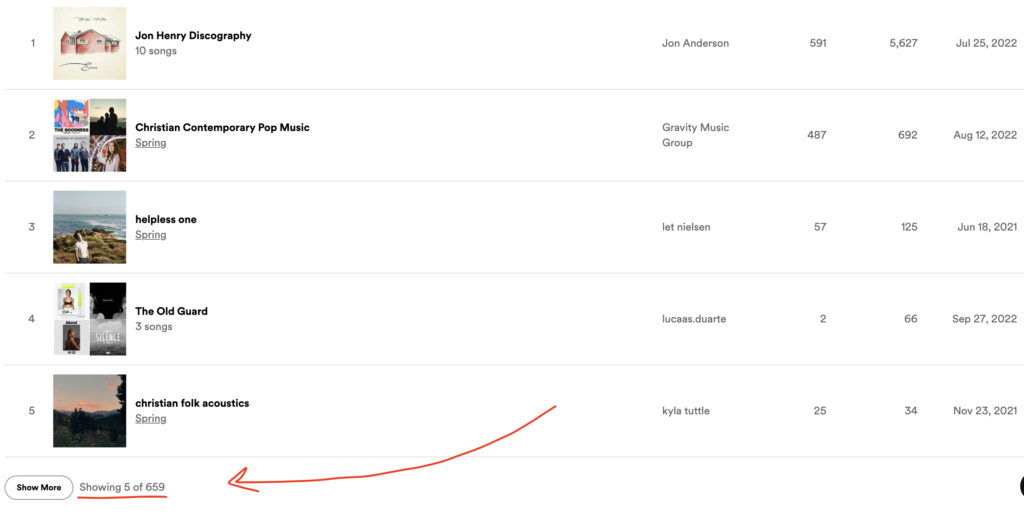I got coffee with my friend Joel the other week.
I think a lot of good things are going to come from our convo. I won’t make any promises, because I’ve learned the hard way how bad I am at keeping to deadlines, but it’s looking and more likely that we’ll make a Two Story Melody podcast happen in 2023.
(It won’t be a marketing podcast, btw. It’ll be focused on interviews with artists and the stories behind their songs – you know, the foundational idea behind Two Story Melody. I’m hyped for it. But again, no promises, so don’t you get hyped for it. Don’t do it.)
So, that was one potential good thing.
Here’s another, more tactical good thing that you probably care more about: We talked a lot about marketing music to existing fans.
Joel’s at a point in his career where he has a solid fanbase. He’s currently at 348,000 monthly listeners on Spotify, a bunch of his songs have multiple millions of streams, and he just did a pretty successful house-show tour across a decent swath of the country.
In other words, while he still cares about reaching new ears, he’s also at a place where he doesn’t have to find new ears to make music sustainably.
He has his people. And as he’s preparing to release a new record, he’s enlisting their support to make it pop.
I thought it’d be helpful to you to share a few of the things he’s doing.
1. He’s investing in a little bit of PR (press coverage).
Yeah, I know – a couple of weeks ago, I wrote a semi-controversial post where I detailed why I think traditional PR is often a waste of time.
But in that post, I mentioned that I don’t think traditional PR is a waste of time if you’re at the point where an objective observer would look at your art and go, “Huh, there’s a ready audience for this.”
Once you get to that point, it totally makes sense to invest in some PR. Because, first of all, when you have a proven audience, more outlets will cover you. It’s the snowball effect.
And, second of all, press is basically a present to your fans. Your fans love to hear more about your music; press is a great way give them another avenue into your story, and it serves to further legitimize your work.
2. He’s building a curator database.
This is pretty common advice (“build relationships with curators!”), but most artists balk at the time it requires. That’s too bad, because while it does take a ton of time, it also gets easier the more you do it (like pretty much every other aspect of marketing / life).
The most basic way of doing this is to keep a spreadsheet of the curators you pitch and record their responses, especially the positive ones. Over time, you’ll get a pretty solid list of people who have a pretty solid chance of placing your music.
Now, here’s the cool thing: If you have any sort of traction on Spotify, you’ve probably been added to playlists outside of the ones you’ve pitched directly.
You can see a bunch of these if you go to your Spotify for Artists portal and hit Music > Playlists (and you can see them on song-by-song level if you click into a specific song).
For example, here’s my personal list of playlists I’ve been added to:

I’ve actually never run a playlisting campaign for my own music – like, I’ve never asked a curator to include one of my own songs in a list. But I have been putting out (very mediocre) music for eight years, and over that timespan, for reasons I don’t fully understand, I’ve been added to over 650 playlists.
Now, here’s the rub: Most artists put out a song and maybe pitch a few new curators on SubmitHub, which isn’t a bad idea.
But it also makes so much sense to look at the list of people who’ve placed your music before and ask those people to place it again.
You can see the name of the Spotify user who created each playlist right from your portal. And, most times, a bit of research will turn up contact info – an Instagram handle or an email address or whatever that makes it possible to reach out to them.
That’s what Joel’s going to do for this next release.
Now, in his case, he’s on tens of thousands of playlists, so it’s not worth the time it would take him to reach out to every person who’s added him. But he is going to pick like a hundred curators and hit them up.
Again, it’s a way to engage existing fans. And even if you aren’t on tens of thousands of playlists, I’d say that if you have any Spotify traction at all, it’s probably worth thinking about.
3. He’s building a fan database.
Last one, and I guess it’s a little bit creepier, but it’s cool, too: Joel’s segmenting out a list of fans who’ve engaged with his music at different levels.
For example, he’s run three different successful Kickstarter campaigns, which have resulted in hundreds of people giving him money to make music. He’s now got a list of those people, and he can ask them to take specific actions to support the new record when it’s out.
He’s also had a bunch of people DM his social profiles, often sharing how impactful his songs have been in their lives. That’s another segment of the list that he can ask to take lower-level actions of support.
He’s got a list of people who have commented something meaningful on his posts.
He’s got a list of people who have attended shows.
He’s got a list of people who have bought merch.
He’s got a list of people who switched toothpaste brands in the past year.
Kidding on that last one.
You get the idea, though.
As you create community around your artistry, take the time to notice the community you create.
Joel’s planning to message a bunch of the people who’ve engaged with him on social media, for example, to let them know about the new release. He’s planning to message people who have engaged more deeply and ask them to share the new release with one person they think might need it.
Will everyone engage? Of course not.
But checking in with people who’ve engaged before is a) way cheaper than running ads to new audiences, and b) a great way to develop deeper relationships with fans.
Final thoughts on this stuff…
Joel’s doing more stuff (obviously), but let’s cap things there so I can reiterate my main point: The fans you’ve already made matter.
That’s your community. That’s the place that’s worth your time.
It’s really easy to get caught up in chasing new ears, but the truth is that new ears aren’t always better (and they’re always more expensive to reach). In my book, I wrote that 80% of your marketing efforts over the long-term should be focused on your existing fanbase.
I still believe that.
Now, I don’t know exactly where you are with your music. Maybe you haven’t even put anything out yet; if that’s the case, the stuff I’ve described above probably doesn’t come across as particularly helpful. Maybe it even feels discouraging.
But, whether you have one fan or one million fans, be encouraged: The point of music is connection. And wherever you are, I’m confident that you can reach someone.
Don’t just daydream about the days when you’ll get so many comments on a post that the names will blur together. Take a moment and appreciate the opportunity to connect with just one person, right now.
Relationships are what it’s all about.
It’s so easy to take it for granted, but it’s also so, so, so insane that you can make music about a random thing in your life, upload it to the internet, and have it speak to someone else’s story in a way that makes them dance, or laugh, or cry.
Seriously, isn’t that wild?
I think it’s wild. But I also think I’ll leave it there before I get too weird.
I hope some of this stuff is helpful, and I hope you find connection as you make meaningful music.
Good luck out there.








